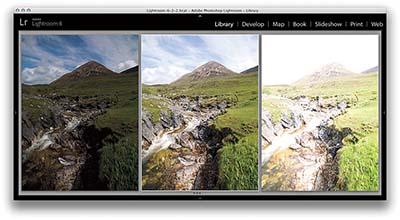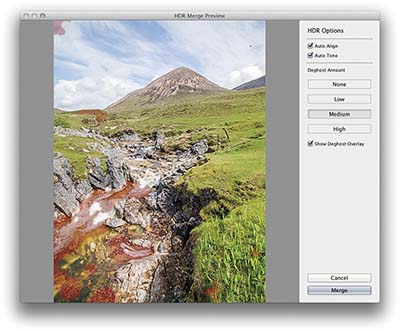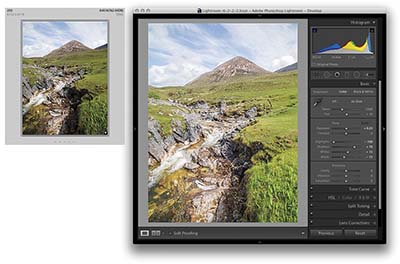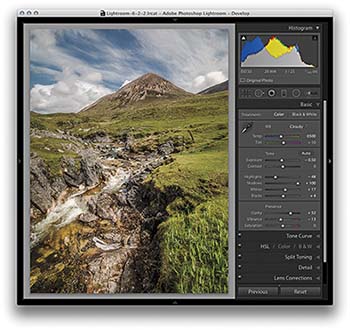Creating HDR Photos Using Photo Merge in Adobe Photoshop Lightroom CC
Lightroom CC now offers a Photo Merge feature, which can be used to process raw or non-raw images to produce a master DNG file. So far, Photo Merge can be used to generate high dynamic range (HDR) or panorama images. Hopefully, in the future it will be possible to offer focus stacking as well. Interestingly, Thomas Knoll included transparency support to DNG several years ago anticipating the possibility of carrying out Photo Merge processing at some point in the future with Camera Raw and Lightroom. So let’s start by looking at how Photo Merge can be used to create HDR DNGs.
The principle here is the same as when using the Merge to HDR Pro method in Photoshop. You need to start with two or more photos of a subject that have been shot using different exposure settings. Also note that when processing photos using the Photo Merge feature, you cannot mix raw and non-raw files.
The key things to remember are that the photographs need to be shot from the same position. Ideally, you want to shoot the photos with the camera firmly mounted on a tripod. When making the exposures, the lens aperture must remain fixed, and you should vary the time duration. Typically, exposures should be bracketed in two-stop increments. You can shoot a bracketed sequence of three, five, or seven images even, and thereby end up with a merged file that has a greater dynamic range. It is crucial that nothing in the scene you are photographing moves between exposures, which means it is not a suitable technique to use when photographing moving subjects. Cloud movement can be okay, providing the clouds do not move too much. In fact, the deghosting algorithm used in Lightroom should produce fewer ghosting issues with cloudy sky images compared to working with Merge to HDR Pro in Photoshop. Moving water and trees can present problems, but the deghosting option can still help resolve such issues. However, it is recommended that you only enable deghosting if you feel it is necessary to do so (Lightroom offers a range of settings from None to High). The method used in Lightroom may utilize more than one image to deghost the resulting HDR. When it works it is great, but it can sometimes lead to unwanted artifacts in the final image, so it is best to leave it at the default “None” setting if you do not need it.
When using the Photo Merge feature in Lightroom, you will find the results you get will be slightly different from using Merge to HDR Pro in Photoshop. The processing technique used is not exactly the same. Therefore, you may find some results you get using Lightroom in this way will be better, or sometimes worse. According to the engineers, it can be really effective when processing just two image exposures, where, for example, you have a landscape subject and one capture is exposed for the ground and the other for the sky. The overall objective here has been to allow users to simply extend the dynamic range prior to carrying out regular Develop module processing. It can be argued that many raw images already do have a high dynamic range. Consequently, there should not necessarily be a huge difference when editing Photo Merge HDR photos compared to regular raw photos.
Photo Merge DNGs
To open Photo Merge in “headless” mode, hold down theShift key as you select via the menu. In this mode, Lightroom processes the photos automatically without showing a dialog. Otherwise, you will see the dialog shown in Step 2, where you have the option to control the settings. If the photos were shot handheld, you will need to select the Auto Align option. It can also help to select Auto Tone, which will apply a suitable auto tone adjustment during the Photo Merge HDR DNG creation process. If Auto Tone is unchecked, default tone settings will be applied.
The resulting DNGs from an HDR Photo Merge are saved as 16-bit floating point files, where the merged data is raw linear RGB data (see Figure 4.35). The DNG files may therefore be quite large in size. You could argue these are not truly raw files, but DNGs produced this way are still mostly unprocessed and allow you to make creative color and tone decisions via the Lightroom Develop module. You also retain the flexibility to reprocess the resulting DNG files any time you like and apply later process versions. Essentially, it means you can merge raw files to create an unprocessed master where you can then fine-tune the settings at the post–Photo Merge stage, adjusting things like the white balance and endpoint clipping. This is particularly helpful when using the Photo Merge feature in Panorama mode.
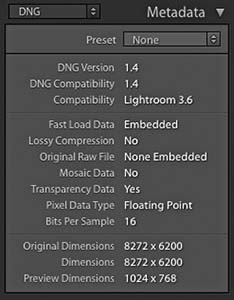
Figure 4.35 This shows the Metadata panel in DNG mode where a Photo Merge HDR DNG file was selected. The Pixel Data Type shows this image uses floating point rather than integer image data.
- To demonstrate the Photo Merge feature in HDR mode, I went to the Library module and selected the three photographs here, which are displayed in the Survey view mode. These photos were shot bracketed, with two stops exposure difference between each capture. While in the Library module, I went to the Photo menu and chose Photo Merge ➯ HDR.
- This opened the HDR Merge Preview dialog, where I had the option to check Auto Align (to ensure the images were in register) and check Auto Tone to apply an auto adjustment. Because this scene featured fast flowing water, I selected a Medium Deghost setting (with Show Deghost Overlay checked).
- I clicked the Merge button in the Photo Merge – HDR dialog and this created a DNG HDR master, which was automatically added to the catalog.
- The DNG I had created was named based on the most selected image in the photo selection, with an –HDR suffix to distinguish it from the source images. In this example, the default Develop settings were based on the most selected photo. You will usually want to fine-tune these settings. For example, with this image I applied the Basic panel adjustments shown here. I also adjusted the HSL panel settings and applied a lens correction to the image.
